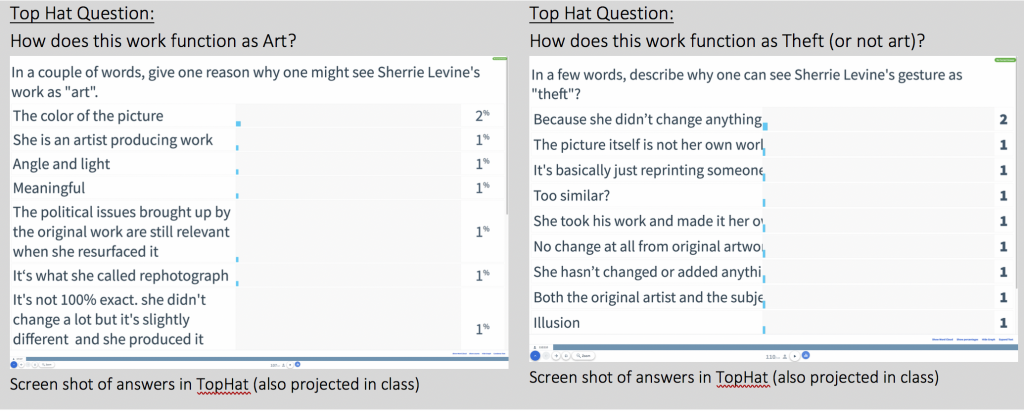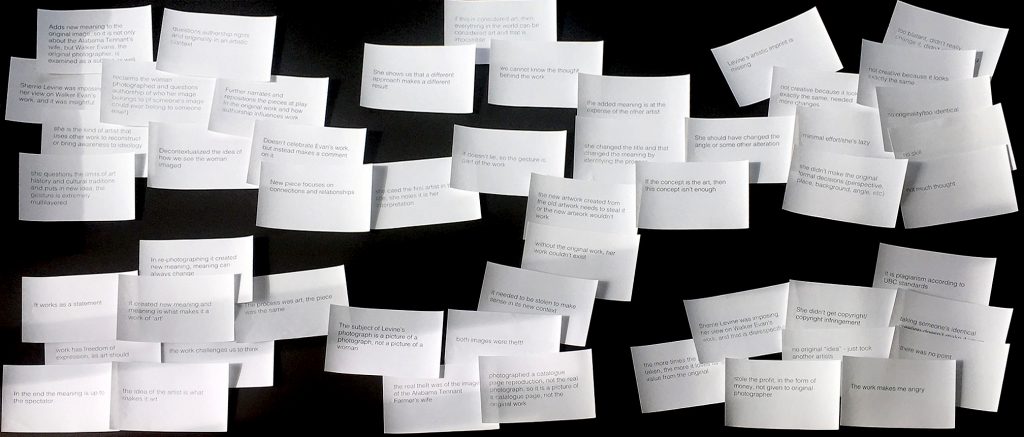February 13-March3 “Mid-Term Critiques”
Outcomes
- Enact a critical outlook as visual readers, recognizing how meaning is cultivated and perpetuated through representation.
- Produce ethical, informed, multi-dimensional, work that is situated in contemporary concerns.
- Activate the process of making, as a way of knowing.
Lectures
The next two lectures introduce the idea of ‘appropriation’ to the students. I will activate responses for a debate map that you can use during the March 5-10 classes if a class trip is not possible.
Debate Map
- Ending on a work by Sherrie Levine, I will ask students to write down on index paper one detailed reason why the work can be considered theft, and one reason why the work can be considered art.
- Continuing the debate of the piece, I will distribute a series of responses on index cards to groups in the lab.
- Students will assemble a “debate map” with the different answers ordered in various ways that evolves the narrative and divide between “Art” and “Theft” (and everything in-between or even both sides!) towards the creation of a skeleton of reasoning. If they wish to add in more labels, such as “both” or “neither” or anything else, they can.
- On blank index cards, have them fill in areas or add points that would complete the map that seem to be missing, if they haven’t already done so.
- By the end, we will go over some of the answers which ultimately give evidence of our values and how they reside in art-making. You may want to ask them to place themselves on an area on the map, or to pick up a card that most represents how they feel about the work.
- In particular, in our contemporary day is skill the main indicator of an a work of art work or artist? Does an artist sometimes have to take a wrong step (stealing) in the right direction (questioning authorship and expertise/authority) in order to bring out larger issues? How does a retelling or appropriation use the initial agency of the work in its new meaning? (This question is vital as for the most part the appropriation projects become music video’s or trailers and lack any uncovering of how the initial footage projected particular ideologies, and how appropriation can expose these and break them down, rather than perpetuate them). You may also want to question if the theft makes them angry, could that affect not be considered art? If they show that they prefer the answer “there was no point” question if there really wasn’t any idea or if they just didn’t like the idea, or if they are somewhat focused on originality you can question if the gesture of re-authoring the work was not original? etc…
For further information on a debate map, please see Derek Bruff’s Agile Learning Blog
Assign: Final (Appropriation) Project due March 26 – 31
Labs
You will have 10 critiques each day over the next two classes. Please record critique participation as the students are graded for their contributions. Remind them that it is not the quantity of things they say, but the quality or thoughtfulness to their fellow peers. Missing a critique day will result in a zero for that day, no exceptions. (Academic advising is recommended for those with extenuating circumstances)
There are many ways to run critiques. It is up to you how you wish to do them but there will be a 4 step approach practiced in the peer review training lecture, and posted to Canvas lecture notes (& handout) that will set them up for the process that they can refer to.
Some guidance:
- Have them open up their projects as soon as they get into class.
- Take the time to describe your critique methods at the beginning so they know what they are going to be doing.
- You can either have the class move around as a group, (can be crowded but also a community oriented feel) to the computers with the work on them, or you can display them on the projector using the side panel to display their computer. Remember, not all computers work with the projector connection, make sure students are on computers that do work.
- You can critique as an entire class (approx 10 minutes each) and talk about each project
or - You can set them up in smaller groups to critique other people’s work for about 5 minutes each. Then gather the class together as a group and have 7-minute critiques each, with the people assigned to the work at the beginning starting the critique for the works they looked at. The method avoids the 3 minutes of silence that may happen when you just blindly go from work to work!
or - I had a past TA who would put pieces of paper next to every computer, and each student had to view each work and write something down about it. This surely helps you record participation marks, but does not really help to engage in a conversation or help guide them in strategies to look at art. But you can think of this as a way to strategize any problematic classes, or as a supplement to a group critique before or afterwards.
- You can have the artist talk about the work at the start, (which can tend to make the group ‘gullible’ to their voiced intention) or you can have ‘silent artist’ critiques where the artist just listens (and perhaps takes notes) to the reception, leaving a minute or two at the end for artists to describe things that the class may have missed.
- Try and keep critical and fair, but also remember that they are vulnerable and sensitive as this might be the first work they’ve ever had work critiqued! Remember how hard that was? Also use this is a learning experience, sometimes what can be learned from one work could be an example for everyone.
- Remind students that we grade their work regardless of what their peer’s say in the class critique, as they are learning how to see work, we are professionals and know how to see the nuances of what they wanted to do, where they did it, where they got distracted, etc…
Homework Reminders
- Module 4 due March 4, 11:59pm


